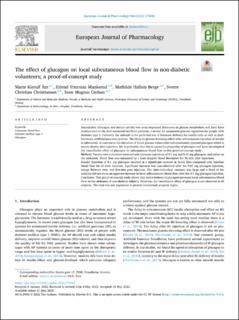| dc.contributor.author | Åm, Marte Kierulf | |
| dc.contributor.author | Munkerud, Erlend Yttersian | |
| dc.contributor.author | Berge, Mathilde Hallem | |
| dc.contributor.author | Christiansen, Sverre Christian | |
| dc.contributor.author | Carlsen, Sven Magnus | |
| dc.date.accessioned | 2023-05-19T08:10:46Z | |
| dc.date.available | 2023-05-19T08:10:46Z | |
| dc.date.created | 2022-05-30T11:12:43Z | |
| dc.date.issued | 2022 | |
| dc.identifier.issn | 0014-2999 | |
| dc.identifier.uri | https://hdl.handle.net/11250/3068292 | |
| dc.description.abstract | Introduction Glucagon and insulin are the two most important hormones for glucose metabolism and have been incorporated in the dual-hormonal artificial pancreas, a device for automated glucose regulation for people with diabetes type 1. Currently the subcutis is the preferred site of hormone delivery for insulin-only as well as dual-hormonal artificial pancreas systems. The delay in glucose-lowering effect after subcutaneous injection of insulin is substantial, in contrast to the elevation of blood glucose values after subcutaneously injected glucagon which is occurs shortly after injection. We hypothesize that this is caused by properties of glucagon and have investigated the vasodilative effect of glucagon on subcutaneous blood flow in this proof-of-concept study. Methods Twenty-two volunteers received subcutaneous injections of 0.1 mg and 0.01 mg glucagon, and saline on the abdomen. Blood flow was measured by a laser doppler blood flowmeter for 35 minutes after injections. Results Injection of 0.1 mg glucagon resulted in a significant increase in blood flow compared with baseline blood flow for all time intervals. Significant increase was also observed after the 0.01 mg glucagon injection, except between two- and five-minutes post injection. The inter-individual variance was large and a third of the subjects did not show an apparent increase in local subcutaneous blood flow after the 0.1 mg glucagon injection. Conclusion This proof-of-concept study shows that micro-boluses of glucagon increase local subcutaneous blood flow on the abdomen of non-diabetic subjects. However, the vasodilative effect of glucagon is not observed in all subjects. The trial was not registered to protect intellectual property rights. | en_US |
| dc.description.abstract | The effect of glucagon on local subcutaneous blood flow in non-diabetic volunteers; a proof-of-concept study | en_US |
| dc.language.iso | eng | en_US |
| dc.publisher | Elsevier | en_US |
| dc.relation.uri | https://www.sciencedirect.com/science/article/pii/S0014299922003065 | |
| dc.rights | Navngivelse 4.0 Internasjonal | * |
| dc.rights.uri | http://creativecommons.org/licenses/by/4.0/deed.no | * |
| dc.title | The effect of glucagon on local subcutaneous blood flow in non-diabetic volunteers; a proof-of-concept study | en_US |
| dc.title.alternative | The effect of glucagon on local subcutaneous blood flow in non-diabetic volunteers; a proof-of-concept study | en_US |
| dc.type | Peer reviewed | en_US |
| dc.type | Journal article | en_US |
| dc.description.version | publishedVersion | en_US |
| dc.source.volume | 926 | en_US |
| dc.source.journal | European Journal of Pharmacology | en_US |
| dc.identifier.doi | 10.1016/j.ejphar.2022.175045 | |
| dc.identifier.cristin | 2028052 | |
| dc.relation.project | Norges forskningsråd: 248872 | en_US |
| cristin.ispublished | true | |
| cristin.fulltext | original | |
| cristin.qualitycode | 1 | |

